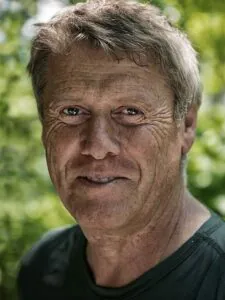Arrange an initial consultation
Management consulting is a matter of trust. Let’s talk briefly about your challenge and find out whether we could work together.

Innovation capability and the ability for continuous renewal are a basic requirement for long-term corporate success.
Today we meet Rick. The need for successful innovation is a fact for Rick. Dwindling drive to innovate and a lack of willingness to change in the workforce present Rick with a challenge. The ADKAR model of successful change helps him to understand the situation and to plan suitable measures.

Rick is an entrepreneur and managing director of the Rick & Sons textile group. In the fifth generation, the company designs and manufactures textiles and workwear. Predominantly for cooks, waiters, carpenters, doctors and law enforcement officers. A role model for successful entrepreneurship. Countless patents have been developed and registered by Rick & Sons. Manufacturing processes and products were unrivaled for a long time. Always in high quality and equipped with the latest functionalities. Odor-inhibiting silver threads and pockets for smartphones are just two examples.
The competition never sleeps. Imported goods are starting to catch up in terms of cost, quality and innovation. The working methods and working environment at Rick & Söhne are no longer up-to-date. Much already seems dusty and outdated. The number of patent applications is falling. New employees do not move towards successful innovations with the same zest for action as previous generations did. The long-established workforce is also beginning to rest on its laurels. Especially now when the roads are getting rockier and successes are getting smaller. Really new ideas and the staff’s enthusiasm for new opportunities are noticeably decreasing. Rick is at a loss.
A look at the workforce:

Norbert started an apprenticeship at Rick & Sons 25 years ago. Since then he has worked his way up to production manager at the main site. Smooth processes. First time right. No experiments. This is what Norbert stands for. The term innovation does not play a role in everyday production. He needs to keep things running, get raw materials and make sure people and machines work as expected.
If the topic of innovation is raised in the management, then Norbert stays out. “I don’t know what all of a sudden everyone always wants with innovation. Cobbler stick to your last. We have always don it like this. And this has been the foundation for our success. Let’s not risk that with crazy experiments. Just leave me alone with your buzzwords.”
Norbert is at “Level Zero” of change. Norbert is not aware of what the topic actually is.

Achim is the quality manager. Incoming goods inspection, material defects and complaints are his daily business. He is aware of the importance of innovation. Advanced manufacturing techniques and materials once brought fame to Rick & Sons. Today the dusty halls can hardly keep up with the competition.
When he thinks of new machines, large investments, errors in the start-up phase and all the stress that comes with it, then he knows: He no longer wants to do that. He is in his final years of work. So basically he just wants to keep a relaxed job in his last years before retirement. And there is little risk of losing his job. He knows that. His official opinion on the subject of innovation is “Our customers expect reliability. We can’t risk anything.”
Achim has reached the “Awareness” level. Achim is aware of what innovation is about and why some people think it is important. But has no need for change. And no desire.

Dagmar leads a team of product developers. New yarns and fabrics for increasing customer requirements are her most important topic. She and her team keep a close eye on innovative products from textile research.
For Dagmar, innovation success means enthusiasm and motivation for her and her team. Dagmar and her team regularly use brainstorming and other creativity techniques to come up with new ideas. There are many ideas. Very few are groundbreaking. Almost none of them make it into production and to the customer. Why is not very clear. “I don’t know how the competition did it again. Always great new ideas. Why didn’t we think of that?”
Dagmar has reached the “Desire” level. Dagmar sees the need for more innovation, but doesn’t know how to do it.

Kristof is a product developer on Dagmar’s team. Innovation is one of his favorite topics. There is hardly a book about innovation that Kristof has not read. He closely follows Outcome Driven Innovation, Design Thinking Workshops, Effectuation, TRIZ, Powerful Thinking, Design for Six Sigma and Lean Startup.
So far he has only been able to use a little of it. Kristof never took part in any practical training. Trying to do a Design Thinking project on his own resulted in frustration on all sides. The topic of innovation methods seems to have burned out. “With an experienced moderator, innovations would no longer be a problem for us.”
Kristof has reached the “Knowledge” level. Kristof knows how innovation works, but cannot translate it into reailty.

Antonia is new to Rick & Sons. As an innovation manager, Antonia should drive innovation projects and bring a breath of fresh air into the organization. Antonia was already able to support many projects with her previous employers She forged new ideas together with teams from all departments and drove the entire innovation process down to market launch.
The Rick & Sons workforce is skeptical about her. There is little support from the executives. But their employees are supposed to participate in innovation projects. “Certainly I could try to manage this alone and burn myself out. All managers have to pull together against the old patterns of the company.”
Antonia has reached the “Ability” level. Antonia is able to create innovations. The circumstances prevent sustainable implementation.

We already know Rick. Rick runs the family business and is the main driving force behind successful innovations. He himself played a major role in many patents and new developments. As an excellent communicator and moderator, it is easy for him to motivate teams. And of course, whenever Rick drives a topic forward, everyone supports. After all, he is the company owner and an authority in the organization. People are not giving him a hard time when he brings up crazy ideas.
But he cannot advance all the issues on his own. The company is too big for that. An independently running innovation process would be ideal. “Of course, innovation is important. In the past, we’ve always succeeded. I don’t know how people can not understand this.”
Rick has reached the “Reinforcement” level. For Rick, innovation is a self-reinforcing pattern of action. He can’t help but doing it.
Those phases describe the ADKAR model. It is a guide to successful change processes from the perspective of the individuals involved. Each person is at a different level on their path to successful change. The path to a company’s ability to innovate is a process of change of many different people.
The following 3 simple steps will help Rick to successfully plan changes in the direction of innovation:
Innovation looks different in every organization and every company. So innovative ability looks different everywhere, too. A concrete description helps to create a common target image. What does it mean when an employee is able to generate innovations? What can he do? How does innovation look like for us? A concise and unambiguous answer for all levels is required.
Which employees are the decisive ones in the change process and at which stage are they? Depending on the corporate culture, the question can be discussed openly, identified with the help of structured interviews or questionnaires, determined by external interview partners or found out with the help of the works council. People whoe are trusted within the organization, mentors and HR developers can often provide valuable insights. The risk of deliberate attempts to manipulate change projects should not be disregarded.
Different measures are differently well suited to accompanying the employees on their way. Decisive influencing factors and questions for the planning of measures are:
A guide to which measures work best in which phases can be found in our whitepaper on the ability to innovate (in German language): “How innovation becomes a sure-fire success with the help of the ADKAR model“.
The implementation of the measures begins after the following detailed and time planning. Communication, workshops, training, coaching are just a few of the possible approaches. Performance reviews are the basis for adjustments to the measures. The foundation stone towards successful and sustainable innovation has been laid.
Further information can be found in the excellent book “Change Management: The people side of change” by the authors Hiatt and Creasey.
Management consulting is a matter of trust. Let’s talk briefly about your challenge and find out whether we could work together.
Innovation always means change. Change for the customer who is supposed to buy something different. Change for the organisation who wants to do things differently. As an innovation consultancy, TOM SPIKE supports you and your industrial, B2B or tech company twoards new products and services on the market. To strengthen the innovation capacity of your organization and create your unique selling propositions with remarkable competitive edge. By conducting condensed innovation workshops, guiding whole innovation projects or supporting teams and individuals with innovation coaching.
How does innovation work? Innovation is on everyone’s lips. Innovation gives...
Best TRIZ Conference ever – that is the prevailing feedback after...
9 Areas for Designing a Successful Innovation System Sporadic, individual initiatives...
You are currently viewing a placeholder content from Google Maps. To access the actual content, click the button below. Please note that doing so will share data with third-party providers.
More Information